Zircon U-Pb, Molybdenite Re-Os and Quartz Vein Rb-Sr Geochronology of the Luobuzhen Au-Ag and Hongshan Cu Deposits, Tibet, China: Implications for the Oligocene-Miocene Porphyry–Epithermal Metallogenic System
Abstract
1. Metallogenic Geological Background
2. Geological Characteristics of Deposit
2.1. Luobuzhen Epithermal Au-Ag Deposit
2.2. Hongshan Porphyry Cu Deposit
3. Sampling and Analytical Methods
4. Results
4.1. Quartz Vein Rb-Sr Isotopic Age
4.2. Zircon U-Pb Ages
4.3. Molybdenite Re-Os Age
5. Discussion
6. Conclusions
Author Contributions
Funding
Acknowledgments
Conflicts of Interest
References
- Jiang, S.H.; Liang, Q.L.; Bagas, L.; Wang, S.H.; Nie, F.J.; Liu, Y.F. Geodynamic setting of the Zijinshan porphyry-epithermal Cu-Au-Mo-Ag ore system, SW Fujian Province, China: Constrains from the geochronology and geochemistry of the igneous rocks. Ore Geol. Rev. 2013, 5, 287–305. [Google Scholar] [CrossRef]
- Li, B.; Jiang, S.Y. Genesis of the giant Zijinshan epithermal Cu-Au and Luoboling porphyry Cu-Mo deposits in the Zijinshan ore district, Fujian Province, SE China: A multi-isotope and trace element investigation. Ore Geol. Rev. 2017, 88, 753–767. [Google Scholar] [CrossRef]
- Hedenquist, J.W.; Arribas, R.; Aoki, M. Zonation of sulfate and sulfide minerals and isotopic composition in the far southeast porphyry and lepanto epithermal Cu-Au deposits, Philippines. Resour. Geol. 2017, 67, 174–196. [Google Scholar] [CrossRef]
- Clifford, M.N.; Ohiokpehai, O.; Menezes, H. Temporal and spatial distribution of alteration, mineralization and fluid inclusions in the transitional high-sulfidation epithermal-porphyry Copper system at Red Mountain, Arizona. J. Geochem. Explor. 2013, 125, 80–93. [Google Scholar]
- Sillitoe, R.H. Porphyry Copper systems. Econ. Geol. 2010, 105, 3–41. [Google Scholar] [CrossRef]
- Corbett, G. Epithermal Gold for explorationists. AIG J. Appl. Geosci. Pract. Res. Aust. 2002, 67, 1–26. [Google Scholar]
- Imai, A. Mineral paragenesis, fluid inclusions and Sulfur isotope systematics of the lepanto far southeast porphyry Cu-Au deposit, Mankayan, Philippines. Resour. Geol. 2010, 50, 151–168. [Google Scholar] [CrossRef]
- Hou, Z.Q.; Cook, N.J. Metallogenesis of the tibetan collisional orogen: A review and introduction to the special issue. Ore Geol. Rev. 2009, 36, 2–24. [Google Scholar] [CrossRef]
- Hou, Z.Q.; Yang, Z.M.; Lu, Y.J.; Kemp, A.; Zheng, Y.C.; Li, Q.Y.; Tang, J.X.; Yang, Z.S.; Duan, L.F. A genetic linkage between subduction- and collision-related porphyry Cu deposits in continental collision zones. Geology 2015, 43, 643–650. [Google Scholar] [CrossRef]
- Wang, Y.; Zhou, L.; Gao, S.; Li, J.W.; Hu, Z.F.; Yang, L.; Hu, Z.C. Variation of Molybdenum isotopes in molybdenite from porphyry and vein Mo deposits in the Gangdese metallogenic belt, Tibetan plateau and its implications. Miner. Depos. 2015, 51, 1–10. [Google Scholar] [CrossRef]
- Yang, Z.M.; Hou, Z.Q.; Chang, Z.S.; Li, Q.Y.; Liu, Y.F.; Qu, H.C.; Sun, M.Y.; Xu, B. Cospatial eocene and miocene granitoids from the JIRU Cu deposit in Tibet: Petrogenesis and implications for the formation of collisional and postcollisional porphyry Cu systems in continental collision zones. Lithos 2016, 245, 243–257. [Google Scholar] [CrossRef]
- Sun, X.; Zheng, Y.Y.; Li, M.; Ouyang, H.T.; Liu, Q.Q.; Jing, X.K.; Sun, G.P.; Song, Q.J. Genesis of luobuzhen Pb-Zn veins: Implications for porphyry Cu systems and exploration targeting at Luobuzhen-Dongshibu in western gangdese belt, southern Tibet. Ore Geol. Rev. 2017, 82, 252–267. [Google Scholar] [CrossRef]
- Xu, J.; Zheng, Y.Y.; Sun, X.; Shen, Y.H. Geochronology and petrogenesis of Miocene granitic intrusions related to the Zhibula Cu skarn deposit in the Gangdese belt, southern Tibet. J. Asian Earth Sci. 2016, 120, 100–116. [Google Scholar] [CrossRef]
- Zhu, D.C.; Zhao, Z.D.; Niu, Y.L.; Mo, X.X.; Chung, S.L.; Hou, Z.Q.; Wang, L.Q.; Wu, F.Y. The Lhasa terrane: Record of a microcontinent and its histories of drift and growth. Earth Planet. Sci. Lett. 2011, 301, 241–255. [Google Scholar] [CrossRef]
- Tang, J.X.; Lang, X.H.; Xie, F.W.; Gao, Y.M.; Li, Z.J.; Huang, Y.; Ding, F.; Yang, H.H.; Zhang, L.; Wang, Q. Geological characteristics and genesis of the Jurassic No. I porphyry Cu-Au deposit in the Xiongcun district, Gangdese porphyry Copper belt, Tibet. Ore Geol. Rev. 2015, 70, 438–456. [Google Scholar] [CrossRef]
- Yang, Z.M.; Lu, Y.J.; Hou, Z.Q.; Chang, Z.S. High-Mg diorite from qulong in southern Tibet: Implications for the Genesis of Adakite-like intrusions and associated porphyry Cu deposits in collisional orogens. J. Petrol. 2015, 56, 227–254. [Google Scholar] [CrossRef]
- Chen, Y.; Zhu, D.C.; Zhao, Z.D.; Meng, F.Y.; Wang, Q.; Santosh, M.; Wang, L.Q.; Dong, G.C.; Mo, X.X. Slab breakoff triggered ca. 113 Ma magmatism around Xainza area of the Lhasa Terrane, Tibet. Gondwana Res. 2014, 26, 449–463. [Google Scholar] [CrossRef]
- Pan, G.T.; Mo, X.X.; Hou, Z.Q.; Zhu, D.C.; Wang, L.Q.; Li, G.M.; Zhao, Z.D.; Geng, Q.R.; Liao, Z.L. Spatial-temporal framework of the Gangdese Orogenic Belt and its evolution. Acta Petrol. Sin. 2006, 22, 521–533. (In Chinese) [Google Scholar]
- Zhu, D.C.; Li, S.M.; Cawood, P.A.; Wang, Q.; Zhao, Z.D.; Liu, S.A.; Wang, L.Q. Assembly of the Lhasa and qiangtang terranes in central Tibet by divergent double subduction. Lithos 2015, 245, 7–17. [Google Scholar] [CrossRef]
- Zhang, Z.M.; Dong, X.; Santosh, M.; Zhao, G.C. Metamorphism and tectonic evolution of the Lhasa terrane, Central Tibet. Gondwana Res. 2014, 25, 170–189. [Google Scholar] [CrossRef]
- Zhu, D.C.; Mo, X.X.; Niu, Y.L.; Zhao, Z.D.; Wang, L.Q.; Liu, Y.S.; Wu, F.Y. Geochemical investigation of Early Cretaceous igneous rocks along an East–West traverse throughout the central Lhasa Terrane, Tibet. Chem.Geol. 2009, 268, 298–312. [Google Scholar] [CrossRef]
- Kang, Z.Q.; Xu, J.F.; Wilde, S.A.; Feng, Z.H.; Chen, J.L.; Wang, B.D.; Fu, W.C.; Pan, H.B. Geochronology and geochemistry of the Sangri Group Volcanic Rocks, Southern Lhasa Terrane: Implications for the early subduction history of the Neo-Tethys and Gangdese Magmatic Arc. Lithos 2014, 200, 157–168. [Google Scholar] [CrossRef]
- Liu, H.; Li, G.M.; Huang, H.X.; Cao, H.W.; Yuan, Q.; Li, Y.X.; Ouyang, Y.; Lan, S.; LÜ, M.; Yan, G. Petrogenesis of late Cretaceous jiangla’angzong I-Type granite in central Lhasa terrane, Tibet, China: Constraints from Whole-Rock geochemistry, zircon U-Pb geochronology, and Sr-Nd-Pb-Hf isotopes. Acta Geol. Sin.-Engl. Ed. 2018, 92, 1396–1414. [Google Scholar] [CrossRef]
- Wang, Q.; Zhu, D.C.; Zhao, Z.D.; Liu, S.A.; Chung, S.L.; Li, S.M.; Liu, D.; Dai, J.G.; Wang, L.Q.; Mo, X.X. Origin of the ca. 90 Ma magnesia-rich volcanic rocks in SW Nyima, central Tibet: Products of lithospheric delamination beneath the Lhasa-Qiangtang collision zone. Lithos 2014, 198, 24–27. [Google Scholar] [CrossRef]
- Zhao, J.X.; Qin, K.Z.; Li, G.M.; Li, J.X.; Xiao, B.; Chen, L.; Yang, Y.H.; Li, C.; Liu, Y.S. Collision-related Genesis of the Sharang porphyry Molybdenum deposit, Tibet: Evidence from zircon U-Pb ages, Re-Os ages and Lu-Hf isotopes. Ore Geol. Rev. 2014, 56, 312–326. [Google Scholar] [CrossRef]
- Wang, R.; Weinberg, R.F.; Collins, W.J.; Richards, J.P.; Zhu, D.C. Origin of postcollisional magmas and formation of porphyry Cu deposits in southern Tibet. Earth-Sci. Rev. 2018, 181, 122–143. [Google Scholar] [CrossRef]
- Zheng, Y.Y.; Zhang, G.Y.; Xu, R.K.; Gao, S.B.; Pang, Y.C.; Cao, L.; Du, A.D.; Dan, Y.R. Geochronologic constraints on magmatic intrusions and mineralization of the Zhunuo porphyry copper deposit in Gangdese, Tibet. Chin. Sci. Bull. 2007, 52, 3139–3147. [Google Scholar] [CrossRef]
- Qu, X.M.; Hou, Z.Q.; Zaw, K.; Li, Y.G. Characteristics and Genesis of gangdese porphyry Copper deposits in the southern tibetan plateau: Preliminary geochemical and geochronological results. Ore Geol. Rev. 2007, 31, 205–223. [Google Scholar]
- Xie, F.W.; Tang, J.X.; Chen, Y.C.; Lang, X.H. Apatite and zircon geochemistry of Jurassic porphyries in the Xiongcun district, southern Gangdese porphyry Copper belt: Implications for petrogenesis and mineralization. Ore Geol. Rev. 2018, 96, 98–114. [Google Scholar] [CrossRef]
- Yang, Z.M.; Goldfarb, R.; Chang, Z.S. Generation of postcollisional porphyry Copper deposits in southern Tibet triggered by subduction of the Indian continental plate. Soc. Econ. Geol. Spec. Publ. 2016, 279–300. [Google Scholar]
- Huang, Y.; Li, G.M.; Ding, J.; Dai, J.; Yan, G.; Dong, S.L.; Huang, H.X. Origin of the newly discovered zhunuo porphyry Cu-Mo-Au deposit in the western part of the gangdese porphyry Copper belt in the southern tibetan plateau, sw China. Acta Geol. Sin.-Engl. Ed. 2017, 91, 109–134. [Google Scholar] [CrossRef]
- Zheng, Y.Y.; Sun, X.; Gao, S.B.; Zhao, Z.D.; Zhang, G.Y.; Wu, S.; You, Z.M.; Li, J.D. Multiple mineralization events at the Jiru porphyry Copper deposit, southern Tibet: Implications for Eocene and Miocene magma sources and resource potential. J. Asian Earth Sci. 2014, 79, 842–857. [Google Scholar] [CrossRef]
- Yang, Z.M.; Hou, Z.Q.; White, N.C.; Chang, Z.S.; Li, Z.Q.; Song, Y.C. Geology of the post-collisional porphyry Copper-Molybdenum deposit at Qulong, Tibet. Ore Geol. Rev. 2009, 36, 133–159. [Google Scholar] [CrossRef]
- Liang, Y.P.; Zhu, J.; Ci, Q.; He, W.H.; Zhang, K.X. Zircon U-Pb ages and geochemistry of volcanic rock from Linzizong group in Zhunuo area in middle Gangdise Belt, Tibet Plateau. Earth Sci. -J. China Univ. Geosci. 2010, 35, 211–223. (In Chinese) [Google Scholar]
- Zhu, D.C.; Wang, Q.; Zhao, Z.D. Constraining quantitatively the timing and process of continent-continent collision using magmatic record: Method and examples. Sci. China-Earth Sci. 2017, 60, 1040–1056. [Google Scholar] [CrossRef]
- Ludwig, K.R. User’s manual for Isoplot 3.00: A geochronological toolkit for Microsoft Excel, 4. Berkeley Geochronol. Cent. Spec. Publ. 2003, 1–70. [Google Scholar]
- Du, A.D.; Wu, S.Q.; Sun, D.Z.; Wang, S.X.; Qu, W.J.; Richard, M.; Holly, S.; John, M.; Dmitry, M. Preparation and certification of Re-Os dating reference materials: Molybdenites HLP and JDC. Geostand. Geoanal. Res. 2010, 28, 41–52. [Google Scholar] [CrossRef]
- Petke, T.; Diamond, L.W. Rb-Sr dating of sphalerite based on fluid inclusion-host mineral isochrons; a clarification of why it works. Econ. Geol. 1996, 91, 951–956. [Google Scholar] [CrossRef]
- Tretbar, D.R.; Arehart, G.B.; Christensen, J.N. Dating Gold deposition in a Carlin-type Gold deposit using Rb/Sr methods on the mineral galkhaite. Geology 2000, 28, 947–950. [Google Scholar] [CrossRef]
- Dong, L.L.; Wan, B.; Yang, W.Z.; Deng, C.; Chen, Z.Y.; Yang, L.; Cai, K.D.; Xiao, W.J. Rb-Sr geochronology of single gold-bearing pyrite grains from the Katbasu Gold deposit in the South Tianshan, China and its geological significance. Ore Geol. Rev. 2018, 100, 99–110. [Google Scholar] [CrossRef]
- Tafti, R.; Mortensen, J.K.; Lang, J.R.; Rebagliati, M.; Oliver, J.L. Jurassic U-Pb and Re-Os ages for the newly discovered xietongmen Cu-Au porphyry district, Tibet, PRC: Implications for metallogenic epochs in the Southern gangdese belt. Econ. Geol. 2009, 104, 127–136. [Google Scholar] [CrossRef]
- Li, Y.; Selby, D.; Condon, D.J.; Tapster, S.R. Cyclic magmatic-hydrothermal evolution in porphyry systems: High-precision U-Pb and Re-Os geochronology constraints from the Tibetan Qulong porphyry Cu-Mo deposit. Econ. Geol. 2017, 112, 1419–1440. [Google Scholar] [CrossRef]
- Zhao, Y.Y.; Liu, X.F.; Liu, Y.C.; Ci, Q.; Xiao, L.B.; Li, L.; Zhang, X.J. Zircon U-Pb ages and geochemical characteristics of Youqiumi Porphyry Pluton in Cimabanshuo area, Tibet. Earth Sci. -J. China Univ. Geosci. 2018, 43, 4551–4565 (In Chinese). (In Chinese) [Google Scholar]
- Pettke, T.; Diamond, L.W. Oligocene Gold quartz veins at Brusson, NW Alps; Sr isotopes trace the source of ore-bearing fluid to ore a 10-km depth. Econ. Geol. 1997, 92, 389–406. [Google Scholar] [CrossRef]
- Stein, H.J.; Markey, R.J.; Morgan, J.W.; Hannah, J.L.; Scherstén, A. The remarkable Re-Os chronometer in molybdenite: How and why it works. Terr. Nova. 2010, 13, 479–486. [Google Scholar] [CrossRef]
- Mao, J.W.; Zhang, Z.C.; Zhang, Z.H.; Du, A.D. Re-Os isotopic dating of molybdenites in the Xiaoliugou W (Mo) deposit in the northern Qilian mountains and its geological significance. Geochim. Cosmochim. Acta 1999, 63, 1815–1818. [Google Scholar]
- Faure, G. Principles of Isotope Geology; John Wiley Sons Inc.: New York, NY, USA, 1986; pp. 1–592. [Google Scholar]
- Ouyang, H.T.; Sun, X.; Zheng, Y.Y.; Wu, S.; You, Z.M.; Geng, R.R.; Wang, X. Characteristics of Metallogenic fluid in the Luobuzhen Pb-Zn deposit of the Gangdese belt, southern Tibet. Geol. Prospect. 2015, 51, 816–827. (In Chinese) [Google Scholar]
- Li, Y.; Selby, D.; Feely, M.; Costanzo, A.; Li, X.H. Fluid inclusion characteristics and molybdenite Re-Os geochronology of the Qulong porphyry copper-molybdenum deposit, Tibet. Miner. Depos. 2017, 52, 1–22. [Google Scholar] [CrossRef]
- Chen, L.; Qin, K.Z.; Li, G.M.; Li, J.X.; Xiao, B.; Zhao, J.X.; Fan, X. Sm-Nd and Ar-Ar isotopic dating of the NURI Cu-W-Mo deposit in the southern gangdese, Tibet: Implications for the Porphyry-Skarn metallogenic system and metallogenetic epochs of the eastern gangdese: Sm-Nd and Ar-Ar isotopic dating of NURI deposit. Resour. Geol. 2016, 66, 259–273. [Google Scholar] [CrossRef]
- Wang, Q.; Huang, Y.; Dong, S.L.; Yan, G.Q.; You, Q.; Jiang, H.Z.; Zhang, K. Zircon LA-ICP-MS U-Pb geochronology, geochemistry and implications of ore-forming porphyry in Nuri skarn Cu-Mo-W deposit, eastern Gangdise. Miner. Depos. 2018, 37, 571–586. (In Chinese) [Google Scholar]
- Qu, X.M. Relationship between Gangdese porphyry copper deposits and uplifting of southern Tibet plateau: Evidence from multistage zircon of ore-bearing porphyries. Miner. Depos. 2006, 25, 388–400. (In Chinese) [Google Scholar]
- Yan, G.Q.; Wang, X.X.; Huang, Y.; Liu, H.; Huang, H.X.; Tian, N.Y.; Nai, Y.; Zhao, J. Evolution characteristics of Magma in the Nuri superlarge polymetallic deposit, Tibet: Implications for regional mineralization in the Shannan ore cluster area. Acta Geol. Sin. 2018, 92, 2138–2154. (In Chinese) [Google Scholar]
- Zhao, J.X.; Qin, K.Z.; Li, G.M.; Cao, M.J.; Evans, N.J.; Mcinnes, B.A.; Li, J.X.; Xiao, B.; Chen, L. The exhumation history of collision-related mineralizing systems in Tibet: Insights from thermal studies of the Sharang and Yaguila deposits, central Lhasa. Ore Geol. Rev. 2015, 65, 1043–1061. [Google Scholar] [CrossRef]
- Hou, Z.Q.; Zhang, H.R.; Pan, X.F.; Yang, Z.M. Porphyry Cu (-Mo-Au) deposits related to melting of thickened mafic lower crust: Examples from the eastern Tethyan metallogenic domain. Ore Geol. Rev. 2011, 39, 21–45. [Google Scholar] [CrossRef]
- Hou, Z.Q.; Mo, X.X.; Yang, Z.M.; Wang, A.J.; Pan, G.T.; Qu, X.M.; Nie, F.J. Metallogeneses in the collisional orogen of the Qinghai-Tibet Plateau: Tectonic setting, tempo-spatial distribution and ore deposit types. Geol. China 2006, 33, 340–351. (In Chinese) [Google Scholar]
- Tang, J.X.; Wang, Q.; Yang, C.; Ding, S.; Lang, X.H.; Liu, H.F.; Huang, Y.; Zheng, W.B.; Wang, L.Q.; Gao, Y.M.; et al. Two porphyry-epithermal deposit metallogenic subseries in Tibetan Plateau: Practice of “absence prospecting” deposit metallogenic series, eastern Gangdise. Miner. Depos. 2014, 33, 1151–1170. (In Chinese) [Google Scholar]
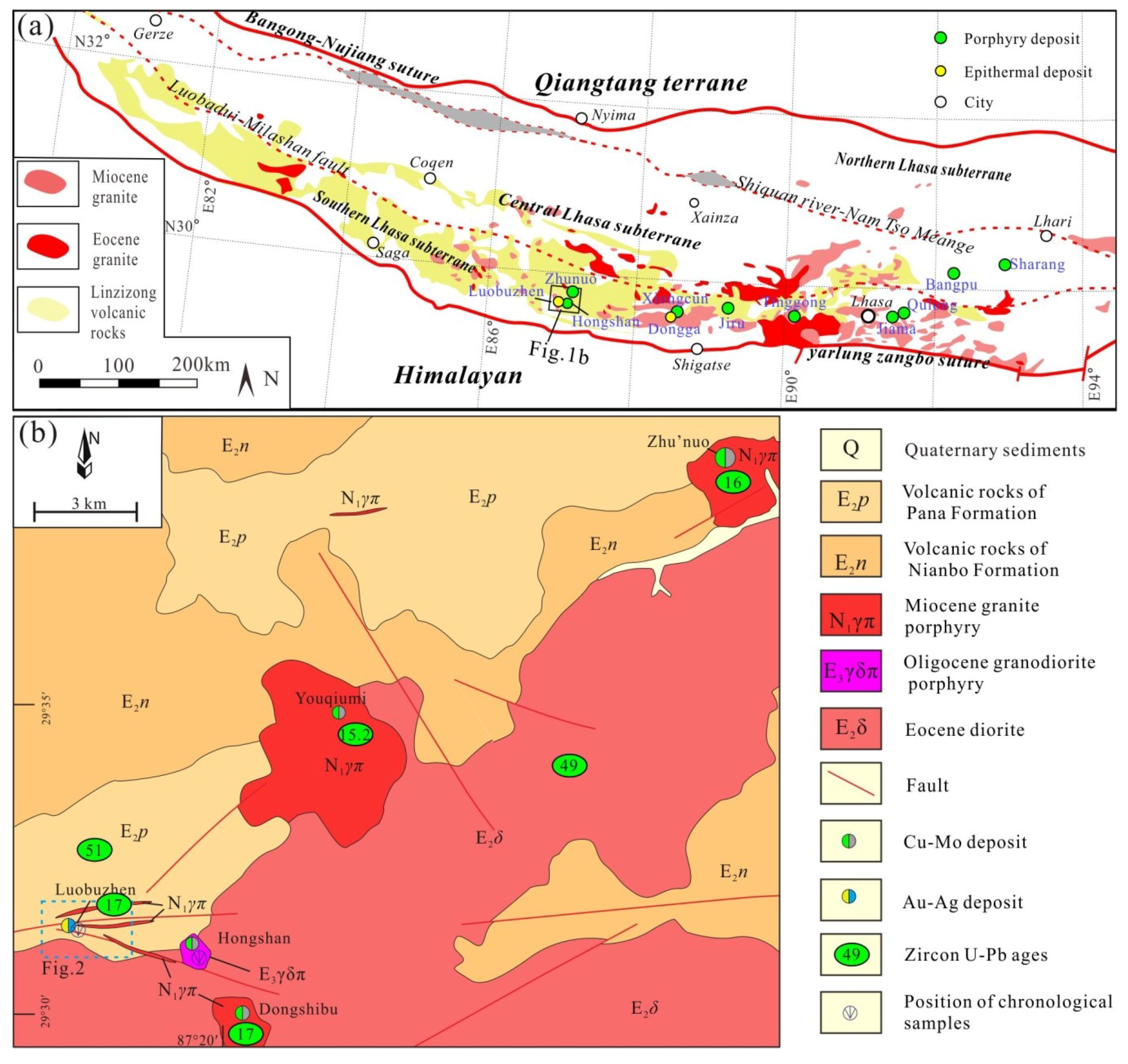
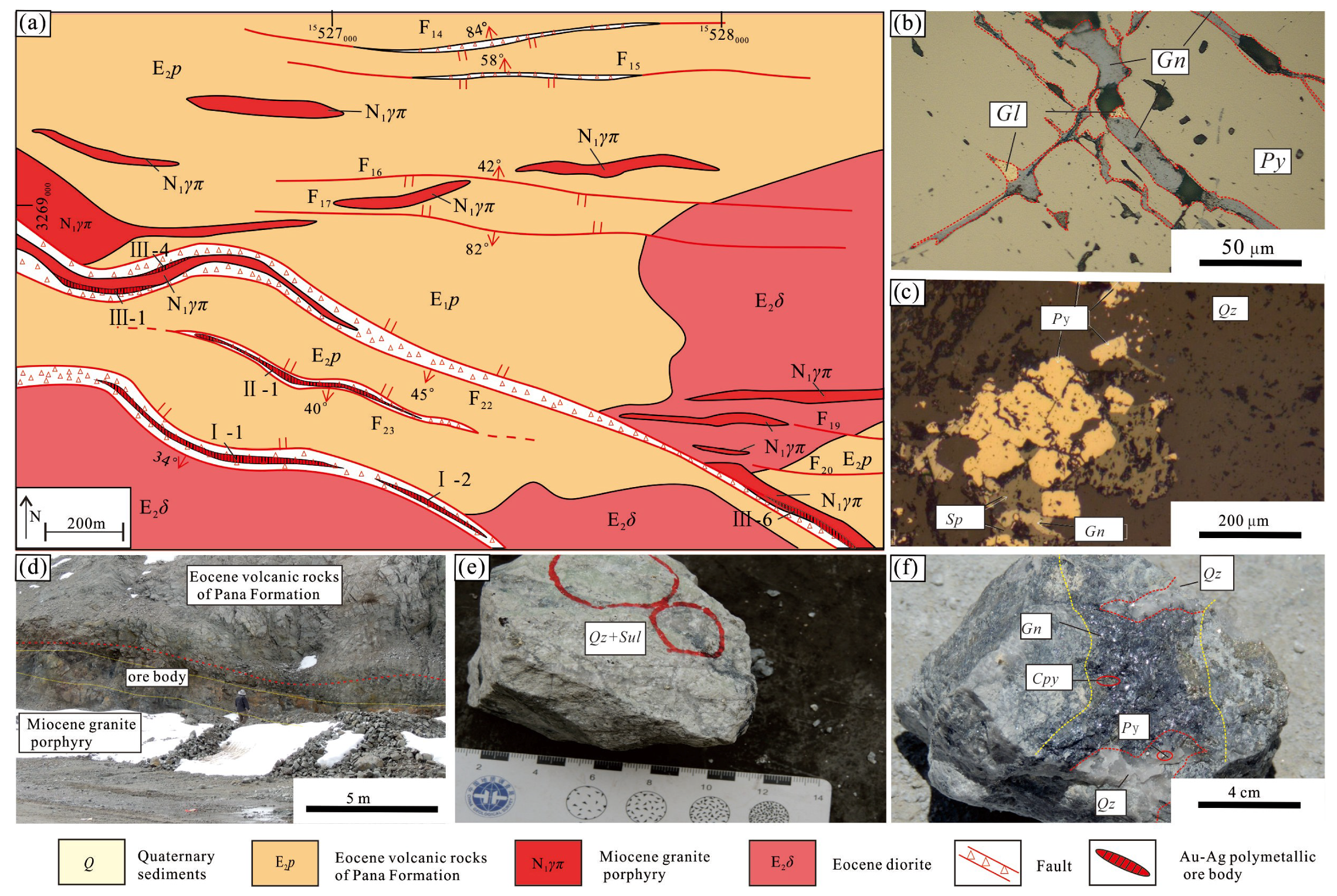
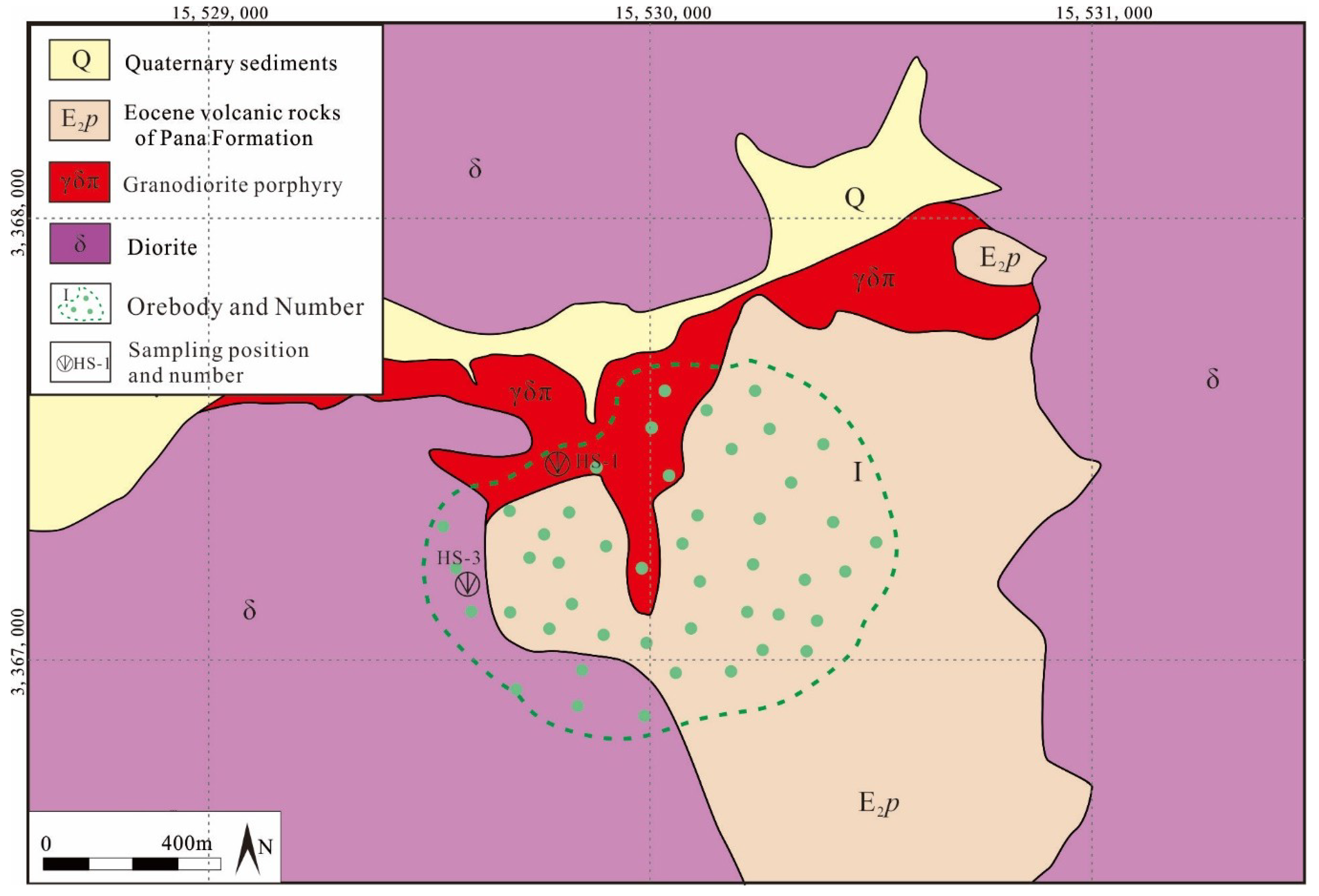
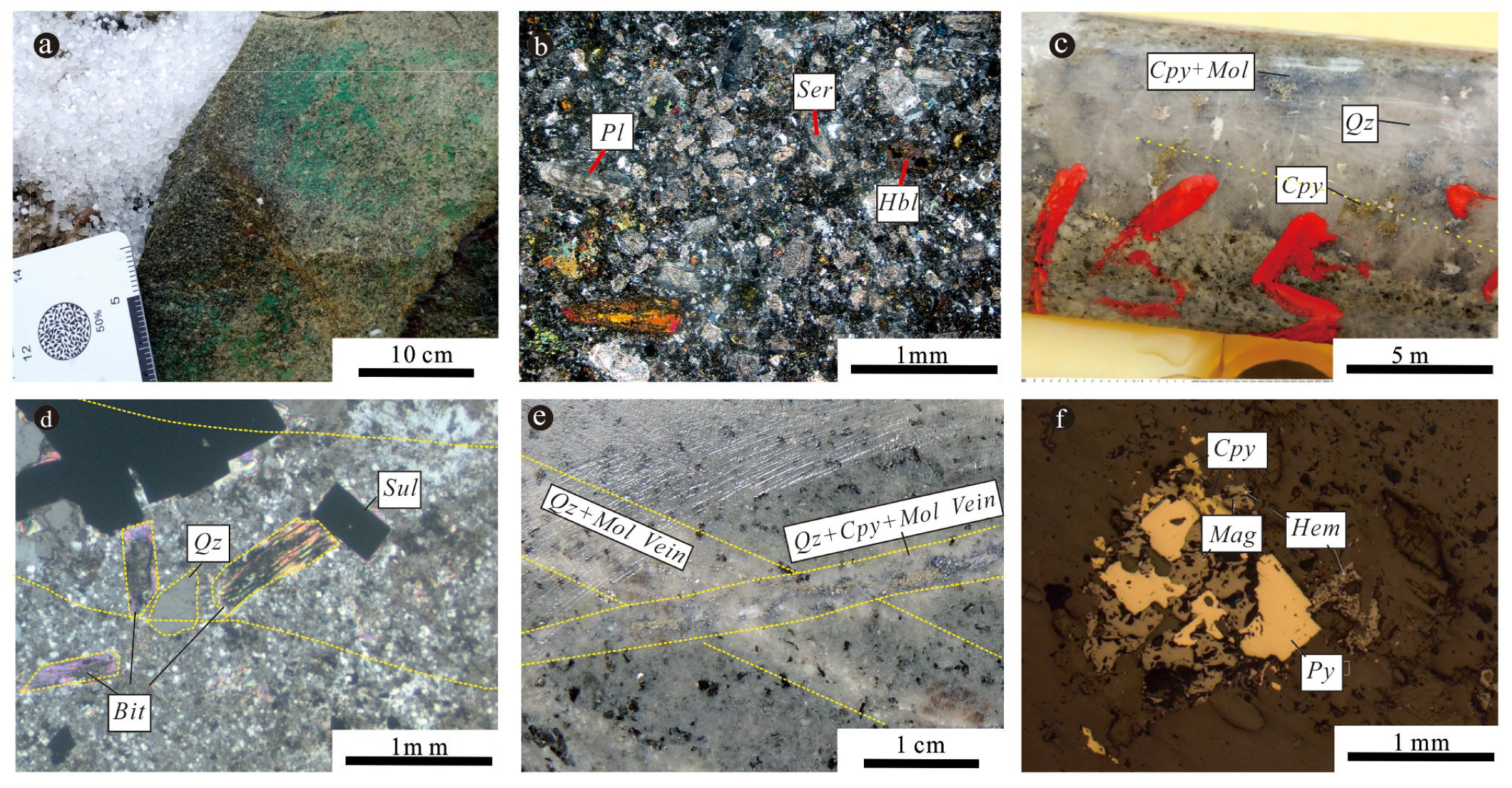

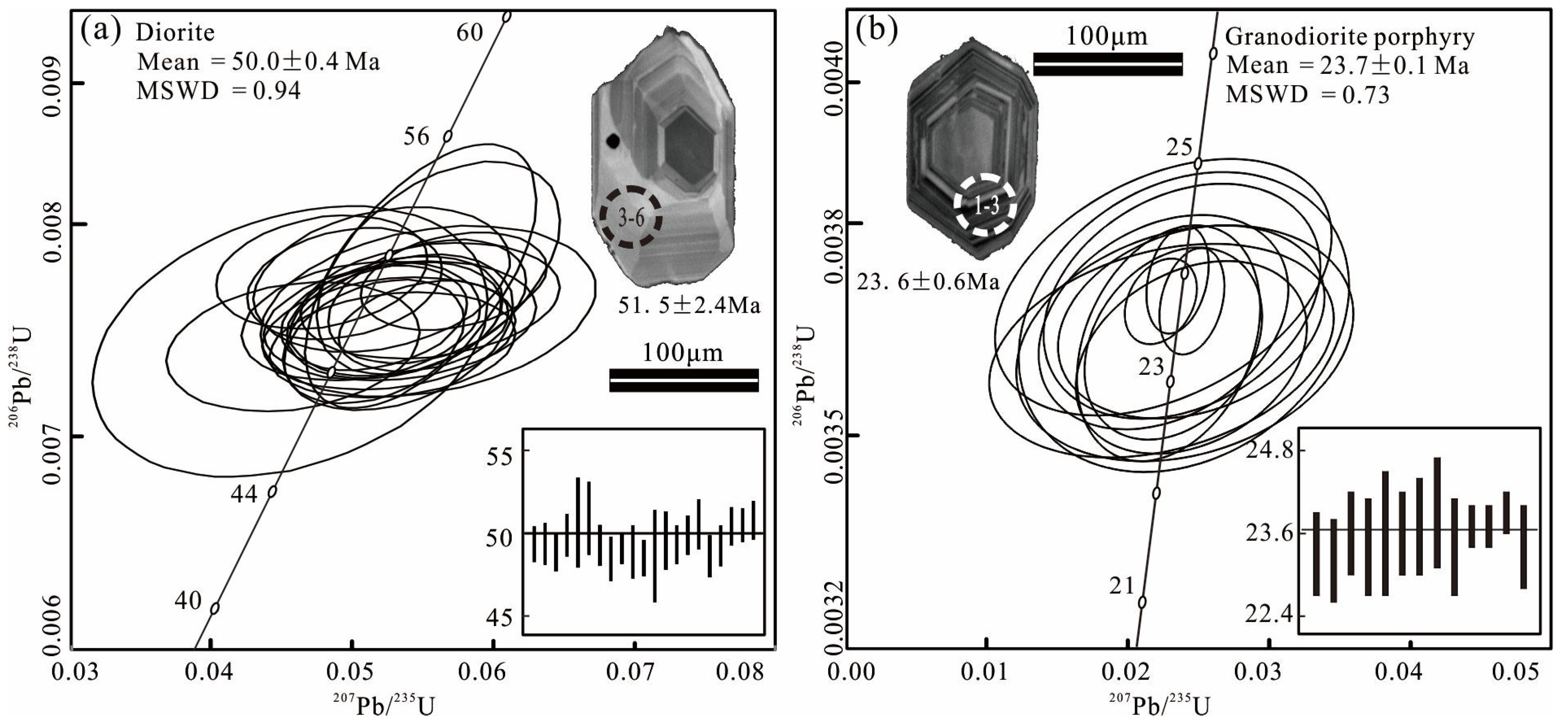
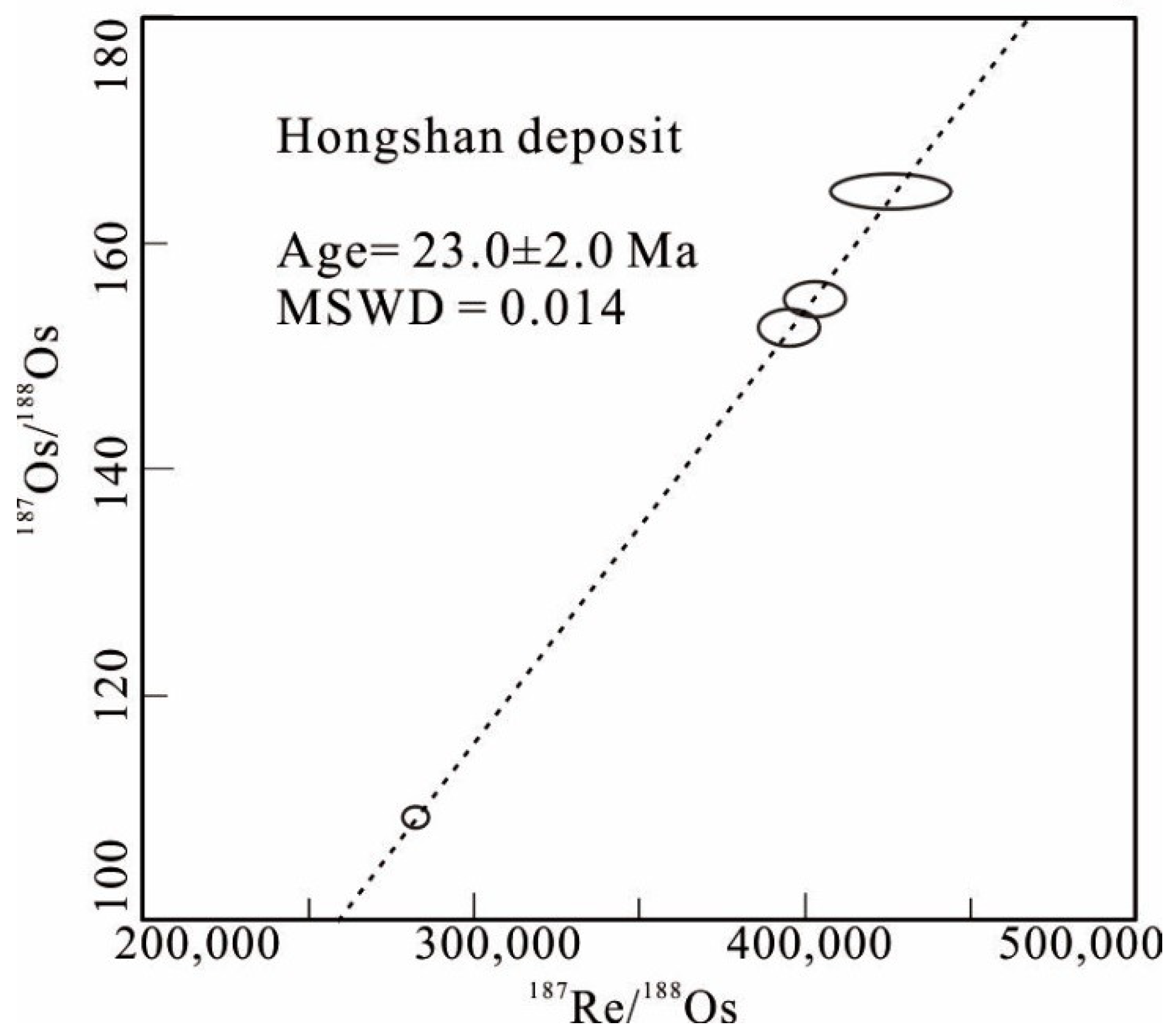
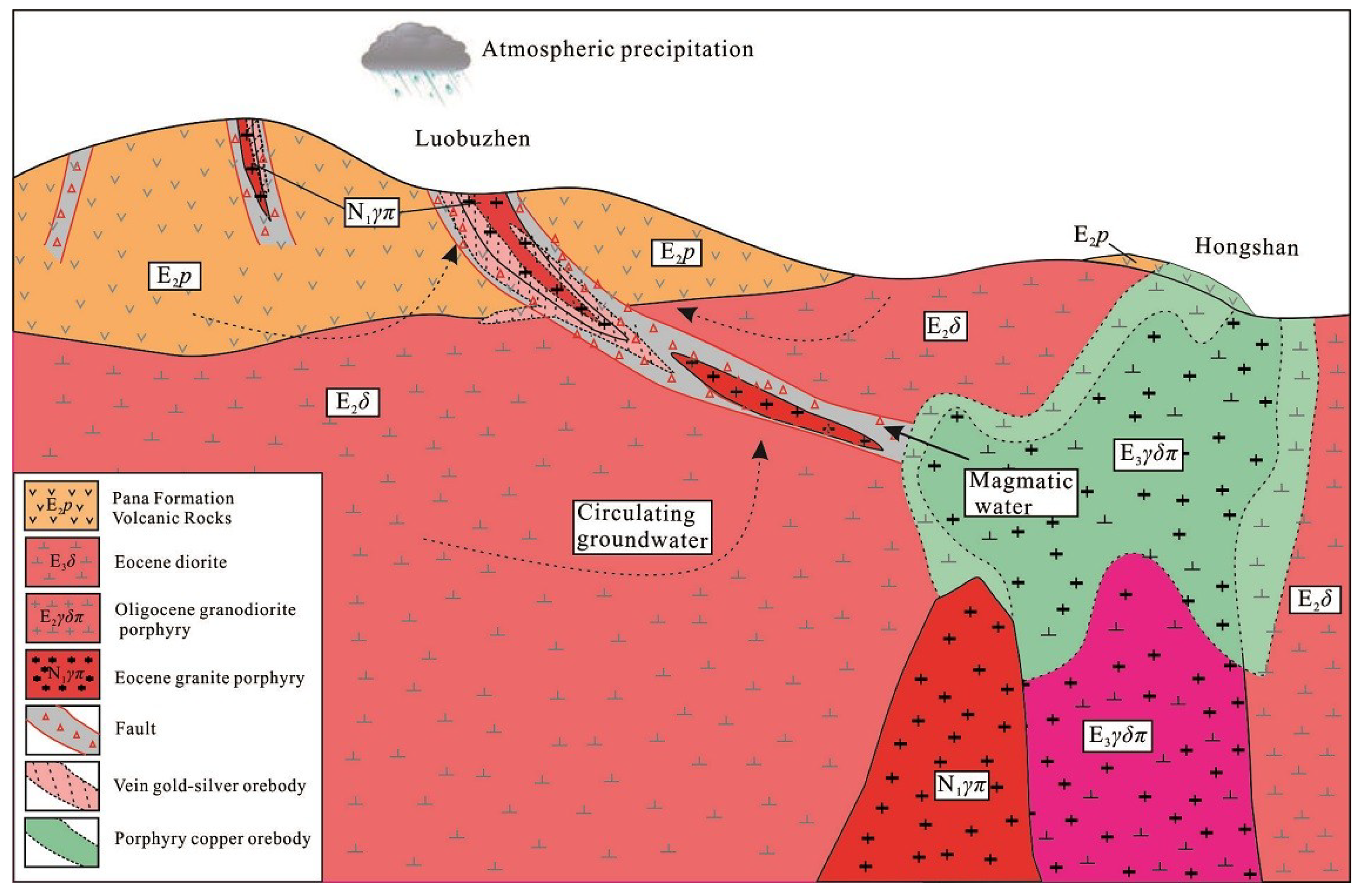
| Sample Number | Name of the Sample | Rb(μg/g) | Sr(μg/g) | 87Rb/86Sr | 87Sr /86Sr | ±1σ |
|---|---|---|---|---|---|---|
| LBZ01 | quartz | 2.05 | 1.28 | 4.616 | 0.70803 | 0.000017 |
| LBZ02 | quartz | 2406 | 657 | 10.606 | 0.70907 | 0.000019 |
| LBZ03 | quartz | 12.1 | 2.72 | 12.911 | 0.71057 | 0.000014 |
| LBZ04 | quartz | 101 | 10.7 | 27.244 | 0.71398 | 0.000012 |
| LBZ05 | quartz | 55.6 | 3.81 | 42.254 | 0.71958 | 0.000017 |
| LBZ06 | quartz | 35.8 | 2.52 | 52.176 | 0.72310 | 0.000011 |
| LBZ07 | quartz | 309 | 5.51 | 145.102 | 0.74960 | 0.000022 |
| Lithology | Spots | Th | U | Th/U | Ratio | Age (Ma) | Concordance | ||||||||||
|---|---|---|---|---|---|---|---|---|---|---|---|---|---|---|---|---|---|
| ppm | ppm | 207Pb/206Pb | 1σ | 207Pb/235U | 1σ | 206Pb/238U | 1σ | 208Pb/232Th | 1σ | 207Pb/235U | 1σ | 206Pb/238U | 1σ | % | |||
| Granodiorite porphyry | HS-1.1 | 94 | 65 | 1.44 | 0.0447 | 0.01623 | 0.0223 | 0.00807 | 0.00362 | 0.0001 | 0.00103 | 0.00007 | 22 | 8 | 23.3 | 0.6 | 94 |
| HS-1.2 | 24 | 79 | 0.30 | 0.04927 | 0.01092 | 0.02451 | 0.00539 | 0.00361 | 0.00009 | 0.00088 | 0.00018 | 25 | 5 | 23.2 | 0.6 | 93 | |
| HS-1.3 | 44 | 116 | 0.38 | 0.04849 | 0.01244 | 0.02443 | 0.00624 | 0.00366 | 0.00009 | 0.00154 | 0.00014 | 25 | 6 | 23.6 | 0.6 | 95 | |
| HS-1.4 | 36 | 72 | 0.50 | 0.04793 | 0.01582 | 0.02398 | 0.00788 | 0.00363 | 0.00011 | 0.00158 | 0.00015 | 24 | 8 | 23.4 | 0.7 | 98 | |
| HS-1.5 | 16 | 50 | 0.31 | 0.04732 | 0.01544 | 0.02389 | 0.00774 | 0.00366 | 0.00014 | 0.00174 | 0.00028 | 24 | 8 | 23.6 | 0.9 | 99 | |
| HS-1.6 | 51 | 65 | 0.78 | 0.04452 | 0.01167 | 0.02244 | 0.00585 | 0.00366 | 0.0001 | 0.00118 | 0.00009 | 23 | 6 | 23.6 | 0.6 | 97 | |
| HS-1.7 | 31 | 73 | 0.43 | 0.04669 | 0.01281 | 0.02377 | 0.00648 | 0.00369 | 0.00011 | 0.0013 | 0.00018 | 24 | 6 | 23.7 | 0.7 | 99 | |
| HS-1.8 | 203 | 118 | 1.72 | 0.04379 | 0.01546 | 0.02242 | 0.00788 | 0.00371 | 0.00012 | 0.00162 | 0.00006 | 23 | 8 | 23.9 | 0.8 | 96 | |
| HS-1.9 | 31 | 125 | 0.25 | 0.04557 | 0.00867 | 0.02279 | 0.00428 | 0.00363 | 0.00011 | 0.00113 | 0.00017 | 23 | 4 | 23.4 | 0.7 | 98 | |
| HS-1.10 | 51 | 188 | 0.27 | 0.04811 | 0.0031 | 0.02446 | 0.00153 | 0.00369 | 0.00005 | 0.00149 | 0.00006 | 25 | 2 | 23.7 | 0.3 | 95 | |
| HS-1.11 | 52 | 145 | 0.36 | 0.04377 | 0.00338 | 0.02224 | 0.00169 | 0.00369 | 0.00004 | 0.00121 | 0.00006 | 22 | 2 | 23.7 | 0.3 | 92 | |
| HS-1.12 | 60 | 143 | 0.42 | 0.04566 | 0.00291 | 0.02343 | 0.00146 | 0.00372 | 0.00005 | 0.00135 | 0.00004 | 24 | 1 | 23.9 | 0.3 | 99 | |
| HS-1.13 | 20 | 36 | 0.55 | 0.04628 | 0.00841 | 0.02314 | 0.00416 | 0.00363 | 0.00009 | 0.00138 | 0.0001 | 23 | 4 | 23.4 | 0.6 | 98 | |
| Diorite | HS3-1 | 612 | 680 | 0.90 | 0.0493 | 0.0051 | 0.0514 | 0.0044 | 0.0078 | 0.0002 | 0.0026 | 0.0001 | 50.9 | 4.2 | 49.8 | 1.2 | 97 |
| HS3-2 | 518 | 585 | 0.88 | 0.0513 | 0.0057 | 0.0529 | 0.0051 | 0.0078 | 0.0002 | 0.0025 | 0.0001 | 52.3 | 4.9 | 49.9 | 1.4 | 95 | |
| HS3-3 | 483 | 531 | 0.91 | 0.0531 | 0.0065 | 0.0525 | 0.0059 | 0.0077 | 0.0002 | 0.0026 | 0.0001 | 51.9 | 5.7 | 49.3 | 1.3 | 94 | |
| HS3-4 | 557 | 647 | 0.86 | 0.0517 | 0.0051 | 0.0552 | 0.0046 | 0.0079 | 0.0002 | 0.0029 | 0.0001 | 54.5 | 4.5 | 50.4 | 1.4 | 92 | |
| HS3-5 | 466 | 518 | 0.90 | 0.0529 | 0.0057 | 0.0547 | 0.0054 | 0.0080 | 0.0005 | 0.0026 | 0.0002 | 54.1 | 5.2 | 51.2 | 2.9 | 94 | |
| HS3-6 | 166 | 168 | 0.99 | 0.0582 | 0.0086 | 0.0560 | 0.0057 | 0.0080 | 0.0004 | 0.0025 | 0.0002 | 55.3 | 5.5 | 51.5 | 2.4 | 92 | |
| HS3-7 | 439 | 459 | 0.96 | 0.0513 | 0.0065 | 0.0505 | 0.0056 | 0.0077 | 0.0002 | 0.0026 | 0.0001 | 50.0 | 5.4 | 49.8 | 1.3 | 99 | |
| HS3-8 | 425 | 482 | 0.88 | 0.0462 | 0.0069 | 0.0457 | 0.0060 | 0.0076 | 0.0002 | 0.0023 | 0.0001 | 45.3 | 5.8 | 48.9 | 1.4 | 92 | |
| HS3-9 | 660 | 675 | 0.98 | 0.0535 | 0.0046 | 0.0549 | 0.0040 | 0.0077 | 0.0002 | 0.0026 | 0.0001 | 54.3 | 3.8 | 49.6 | 1.0 | 90 | |
| HS3-10 | 391 | 454 | 0.86 | 0.0538 | 0.0075 | 0.0531 | 0.0054 | 0.0077 | 0.0003 | 0.0026 | 0.0002 | 52.6 | 5.2 | 49.3 | 1.7 | 93 | |
| HS3-11 | 571 | 653 | 0.87 | 0.0523 | 0.0057 | 0.0527 | 0.0058 | 0.0076 | 0.0002 | 0.0026 | 0.0001 | 52.2 | 5.6 | 48.9 | 1.2 | 93 | |
| HS3-12 | 171 | 249 | 0.69 | 0.0554 | 0.0180 | 0.0455 | 0.0093 | 0.0076 | 0.0005 | 0.0026 | 0.0004 | 45.1 | 9.0 | 49.1 | 3.0 | 91 | |
| HS3-13 | 306 | 355 | 0.86 | 0.0539 | 0.0089 | 0.0552 | 0.0079 | 0.0078 | 0.0003 | 0.0025 | 0.0002 | 54.6 | 7.6 | 50.1 | 1.9 | 91 | |
| HS3-14 | 341 | 437 | 0.78 | 0.0523 | 0.0056 | 0.0530 | 0.0049 | 0.0078 | 0.0002 | 0.0025 | 0.0001 | 52.4 | 4.8 | 49.8 | 1.3 | 94 | |
| HS3-15 | 389 | 453 | 0.86 | 0.0533 | 0.0061 | 0.0554 | 0.0061 | 0.0079 | 0.0002 | 0.0026 | 0.0001 | 54.8 | 5.9 | 50.4 | 1.3 | 91 | |
| HS3-16 | 439 | 536 | 0.82 | 0.0490 | 0.0069 | 0.0520 | 0.0060 | 0.0080 | 0.0003 | 0.0026 | 0.0002 | 51.4 | 5.8 | 51.1 | 1.6 | 99 | |
| HS3-17 | 416 | 413 | 1.01 | 0.0551 | 0.0071 | 0.0514 | 0.0042 | 0.0076 | 0.0002 | 0.0028 | 0.0001 | 50.9 | 4.1 | 49.0 | 1.4 | 96 | |
| HS3-18 | 348 | 430 | 0.81 | 0.0546 | 0.0076 | 0.0533 | 0.0064 | 0.0077 | 0.0002 | 0.0022 | 0.0001 | 52.7 | 6.2 | 49.7 | 1.3 | 94 | |
| HS3-19 | 451 | 500 | 0.90 | 0.0481 | 0.0054 | 0.0493 | 0.0046 | 0.0079 | 0.0002 | 0.0025 | 0.0001 | 48.8 | 4.4 | 51.0 | 1.2 | 95 | |
| HS3-20 | 608 | 712 | 0.85 | 0.0540 | 0.0049 | 0.0571 | 0.0044 | 0.0080 | 0.0002 | 0.0024 | 0.0001 | 56.4 | 4.2 | 51.1 | 1.1 | 90 | |
| HS3-21 | 710 | 533 | 1.33 | 0.0464 | 0.0052 | 0.0477 | 0.0050 | 0.0080 | 0.0002 | 0.0025 | 0.0001 | 47.3 | 4.8 | 51.4 | 1.3 | 91 | |
| SampleID | w(Re)/(ng/g) | w (Normal Os)/(ng/g) | w(187Re)/(ng/g) | w(187Os)/(ng/g) | Model Age/ma | |||||
|---|---|---|---|---|---|---|---|---|---|---|
| Tested Value | σ | Tested Value | σ | Tested Value | σ | Tested Value | σ | Tested Value | σ | |
| VZK2-20 | 677,887 | 19,144 | 0.3056 | 0.0126 | 426,065 | 12033 | 164.6 | 1.0 | 23.19 | 0.71 |
| VZK1-1 | 449,238 | 3888 | 2.475 | 1.542 | 282,355 | 2444 | 109.2 | 0.7 | 23.20 | 0.33 |
| VZK1-19 | 628,637 | 9604 | 0.6023 | 0.0754 | 395,111 | 6037 | 152.5 | 1.1 | 23.16 | 0.45 |
| VZK3-4 | 641,181 | 9906 | 0.2209 | 0.1192 | 402,995 | 6226 | 155.0 | 1.0 | 23.08 | 0.45 |
© 2019 by the authors. Licensee MDPI, Basel, Switzerland. This article is an open access article distributed under the terms and conditions of the Creative Commons Attribution (CC BY) license (http://creativecommons.org/licenses/by/4.0/).
Share and Cite
Huang, H.; Liu, H.; Li, G.; Zhang, L.; Cao, H.; Zhou, Q.; Wang, X.; Yan, G. Zircon U-Pb, Molybdenite Re-Os and Quartz Vein Rb-Sr Geochronology of the Luobuzhen Au-Ag and Hongshan Cu Deposits, Tibet, China: Implications for the Oligocene-Miocene Porphyry–Epithermal Metallogenic System. Minerals 2019, 9, 476. https://doi.org/10.3390/min9080476
Huang H, Liu H, Li G, Zhang L, Cao H, Zhou Q, Wang X, Yan G. Zircon U-Pb, Molybdenite Re-Os and Quartz Vein Rb-Sr Geochronology of the Luobuzhen Au-Ag and Hongshan Cu Deposits, Tibet, China: Implications for the Oligocene-Miocene Porphyry–Epithermal Metallogenic System. Minerals. 2019; 9(8):476. https://doi.org/10.3390/min9080476
Chicago/Turabian StyleHuang, Hanxiao, Hong Liu, Guangming Li, Linkui Zhang, Huawen Cao, Qing Zhou, Xinxin Wang, and Guoqiang Yan. 2019. "Zircon U-Pb, Molybdenite Re-Os and Quartz Vein Rb-Sr Geochronology of the Luobuzhen Au-Ag and Hongshan Cu Deposits, Tibet, China: Implications for the Oligocene-Miocene Porphyry–Epithermal Metallogenic System" Minerals 9, no. 8: 476. https://doi.org/10.3390/min9080476
APA StyleHuang, H., Liu, H., Li, G., Zhang, L., Cao, H., Zhou, Q., Wang, X., & Yan, G. (2019). Zircon U-Pb, Molybdenite Re-Os and Quartz Vein Rb-Sr Geochronology of the Luobuzhen Au-Ag and Hongshan Cu Deposits, Tibet, China: Implications for the Oligocene-Miocene Porphyry–Epithermal Metallogenic System. Minerals, 9(8), 476. https://doi.org/10.3390/min9080476





